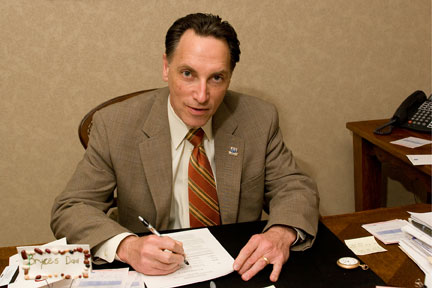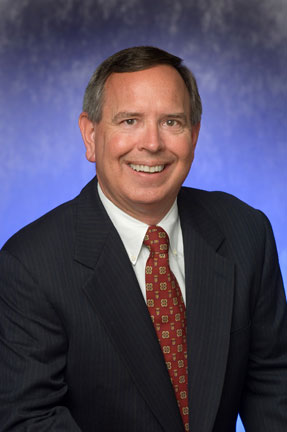John Peter Smith hospital’s emergency room is part of a state-of-the-art medical pavilion, open less than a year. But conditions in the ER’s “green room,” as described recently by one nurse, sounded more like those of a one-doctor hospital in the middle of an epidemic.
 “There were a couple of times when I thought patients were going to start a riot in there,” nurse Joe Snow said. “It’s like you’re taking care of a small town with only two nurses and one technician at a time. … One man can’t take care of an entire army.”
“There were a couple of times when I thought patients were going to start a riot in there,” nurse Joe Snow said. “It’s like you’re taking care of a small town with only two nurses and one technician at a time. … One man can’t take care of an entire army.”
The “green room” is where patients whose ailments have been deemed not immediately life-threatening are sent to be screened while they wait for further treatment … and wait and wait.
Snow, who has worked in the ER for almost five years, described angry patients complaining that their conditions were worsening after waiting as long as 15 or 16 hours to see a doctor. He said he’s seen as many as 80 patients parked there with only two overwhelmed nurses to attend to them. Then there are the patients who somehow slip through the cracks of initial triage evaluations and end up waiting in the green room when they should have gone straight to an ER bed. He talked about conditions so overcrowded and stressful that more than a dozen nurses quit their jobs in the first two months after the new emergency room opened, for fear that they would lose their licenses if something happened to a patient due to the overcrowding and woefully inadequate staffing.
He didn’t expect a Sunday tea party when he signed up to work at a county hospital ER, Snow said, but he never imagined it would be so disorganized. “I understood that when we first moved, there would be growing pains,” he said. “I thought that it would be bad, but it was worse than I ever expected.”
Snow and other JPS emergency room nurses have been so frustrated and scared by ER conditions that they did something that nurses may have never done before in a Fort Worth hospital: They organized so that they could speak as a group. And then they took public action.
In recent weeks, the nurses drafted a petition asking for more staff to be assigned in the green room. And last month, they mailed the petition to management, signed by 28 of the hospital’s 55 ER nurses.
They didn’t do it without fear. In fact, one petition organizer said every ER nurse he spoke to supported the petition’s aims; the ones who declined to sign did so out of fear for their careers. Every nurse interviewed by Fort Worth Weekly for this story said that people in their profession live with the constant threat of retaliation if they raise concerns. In Texas, they have a phrase for one such tactic. It’s called being “Group One’d,” referring to the name of an organization that does background checks on hospital employees and, so nurses believe, is responsible for blacklisting anyone who speaks up.
So why did the nurses step forward this time? Not because conditions at JPS’ emergency room are worse than they’ve ever been; problems there are somewhat legendary.
In part, it was due to the arrival of new CEO Robert Earley, who took the reins at the public hospital and cleaned house. Under his leadership, they felt they might be listened to. Earley, still in his honeymoon period as the CEO, has promised change, and some of the nurses who signed the petition see it as a way to test his sincerity.
But the other part of the equation reaches beyond JPS, to a statewide and national movement. Elsewhere in Texas and around the country, groups of nurses are acting together to work for better patient care, better pay, and better hospital staffing and against what they see as unfair treatment by hospitals. They’re fighting via legislation, lawsuits, petitions, and – even in right-to-work states like Texas – through unionizing.
At JPS, the ER nurses are working with an organization called the National Nurses Organizing Committee, a California-based nurses’ advocate group. Many of the ER nurses are members of the group, which is helping them organize and deal with management. The NNOC does help nurses unionize, but it’s also a professional organization that advances nurses’ concerns through legislation and provides support to nurses who are advocating for patient safety, as is the case at JPS.
NNOC officials are quick to point out that although the JPS nurses are not yet seeking to form a union, they are acting collectively as a union would. In a state where many leaders view unions only slightly more favorably than the Communist Party, NNOC officials say that is a huge step forward.
In California, a law passed a few years ago mandates a patient-to-nurse ratio of 4 to 1 in hospitals; a similar bill is being considered by the Texas Legislature. At a hospital in Houston, the first nurses’ union in Texas has been formed.
Last February, three of the nation’s biggest nurses’ unions combined their efforts and converged on North Texas. The NNOC, along with the California Nurses Association and the Massachusetts Nurses Association, are in the process of merging into the United American Nurses-National Nurses Organizing Committee, which will boast a combined 150,000 members.
According to Shum Preston, a spokesperson for the NNOC, Texas has become the epicenter for the nurses’ union movement. He said there are 10,000 nurses participating in some form of activism in the state. There have already been three marches on the state capitol, with somewhere between 300 to 600 nurses turning out each time to advocate for a better work environment. In their efforts to mobilize Texas nurses, the NNOC has lobbied legislators, sponsored online petitions, run phone banks, and held nurse-led community meetings.
“Texas is one of the hot spots for nurse organizing. It may be because conditions in Texas hospitals tend to be particularly oppressive compared to the national average, based on what I’ve heard,” he said. “It’s an exciting time for nurses in Texas.”
But it’s a tough row to hoe for nurses. Those interviewed for this story said they fear reporting agencies that they believe function like the healthcare profession’s own mafia. Organizations like Group One are often used by managers as a way to keep nurses in line and get them to work in conditions that might be unsafe, nurses said. In some cases, a black mark on a nurse’s Group One report can be career-ending. Even Group One officials acknowledge that managers use the company as a threat, though they said they discourage that. And union-busting law firms employed by hospitals have made fortunes from tracking union activity and opposing it at every turn.
Patients who show up in John Peter Smith’s ER are first evaluated by a triage nurse. If their health problems are critical, they go straight to an ER bed. Those whose complaints don’t seem to be immediately life-threatening are diverted to the green room. For example, if a patient comes in with chest pains, but an EKG examination determines that it is not a heart attack, that patient goes to the green room and receives x-rays, lab work, and a variety of other tests and surveys that don’t require a doctor. The patients are then seen in order of severity of their problems, according to protocol.
Nurses believe that the theory behind the green room is sound. In current practice at JPS, however, those interviewed said the area is potentially dangerous to patients and to the nurses themselves because the staff is routinely overwhelmed by their patient load.
“You can come back with lab [reports] that say that a patient is too sick to be in here [in the green room], but when you have that many patients constantly coming up and yelling, you’ll miss labs,” said Snow.
 The patient-to-nurse ratio in the green room has been as high as 80 to 1, several nurses said. The petition asks Earley to commit to a patient to nurse ratio of 4 to 1 in that area, which would mean a substantial increase in the ER nursing staff.
The patient-to-nurse ratio in the green room has been as high as 80 to 1, several nurses said. The petition asks Earley to commit to a patient to nurse ratio of 4 to 1 in that area, which would mean a substantial increase in the ER nursing staff.
The emergency room at JPS is notorious for its long wait times. The average wait in the ER is well over three hours, according to a consultant’s report. The same report said that more than 15 percent of people who come into the ER leave before they receive treatment. To combat the problem, the hospital spent an additional $40 million to hire more staff last year. Earley also replaced the hospital’s emergency room manager. Last year, Earley himself spent a 12-hour shift in the ER and experienced some of the issues firsthand.
In an e-mail response to the Weekly‘s questions, the hospital CEO acknowledged the petition sent by the nurses and said that he has made improving the ER a priority early in his tenure.
“I agree with their concerns,” he said. “The emergency room is a major concern of mine. That is why six months ago I brought many issues to the board of managers expressing the need to review and suggest change. A special committee was appointed consisting of board members, community members, physicians, nurses, and administration.
“The committee has met weekly for the better part of six months, and a report will most likely be presented at the May board meeting,” he continued. “All emergency rooms in the area are coping with increased volumes.”
The board meeting is scheduled for May 14.
When Earley sent out a memo asking the staff about their concerns, nurses Amy Sullivan, Tim Moisant, and others decided to seize the opportunity. Sullivan collected signatures for the petition during the day shift, and Moisant collected during the night. The nurses were upset that there is no policy at JPS regarding nurse-patient ratios in the triage area or green room. Sullivan said that she tried to address the problem through the proper channels, but her immediate supervisor was unresponsive. The nurses decided to take matters into their own hands and reached out to the NNOC for help.
“After months of them promising us stuff, Early decided to ask for suggestions,” said Moisant. “We got together, and almost everyone I asked signed the petition.”
Both Sullivan and Moisant said that they were aware of the risks involved in speaking out, but the presence of the NNOC has helped assuage some of those fears. When Earley agreed to meet with them, the nurses felt it was a sign that collective action could work.
Moisant set aside his own feelings about unions in order to get something done about his work conditions.
“As a Texan – I was born and raised here, and lived here all my life – I’m totally against unions,” he said. “But there’s no other way. Without us actually organizing and coming together, I don’t see that anything is going to change – not just at JPS, but every hospital. They’re not going to change unless we make them.”
Sullivan said that the green room nurses are focusing on one issue: how to fix that area of the hospital. She admitted that the idea of unionizing has its appeal and may even be on the horizon, but she doesn’t want that controversy to overshadow the ER nurses’ immediate goals.
“That’s not a big emphasis right now; we’re doing baby steps,” she said. “We have the right to collectively join the [NNOC] and come together as nurses for our patients’ safety. The union aspect isn’t even in the works right now.”
Earley said he was aware of the statewide trend toward organized action by nurses. He wouldn’t speculate as to how he would respond to the nurses’ petition.
“I am aware that there are efforts to unionize nursing in the state of Texas; however, that is a matter for the legislature,” he said. “We have had a change of leadership in our nursing administration, and we are currently reviewing this issue.”
Earley listed several ways that the public could help reduce congestion in the ER. He said that crowded conditions are exacerbated by patients who come there looking for routine care or second opinions about their medical problems.
“We hope that with the expansion of our JPS Connection program we will have more patients seeking preventative care [at JPS’ system of community clinics] and therefore fewer people in the emergency department,” he said.
JPS isn’t the only Texas hospital whose staff is working with unions. Last March, the Cypress Fairbanks Medical Center in Houston became the first domino to fall in Texas. The hospital’s nurses unionized, with the assistance of the NNOC. They are still hammering out the details of their contract. The hospital is owned by Dallas-based Tenet Healthcare Corp., the nation’s third-largest publicly traded hospital corporation. The NNOC is also helping nurses pursue unions in Dallas, Austin, and San Antonio, as well as at other hospitals in Houston.
The reasons Patrice McCarthy, a registered nurse at Cypress Fairbanks, gave for her involvement in the union echo the sentiments that nurses around the country have expressed in news stories and on web sites.
“Many of us have been nurses for many years and feel undervalued and unsafe at times,” she said. “When your license is on the line, and you’ve got too many patients, it’s very upsetting to feel like you don’t have support or anywhere to go to address those issues.”
The Texas House and Senate both have bills pending that would mandate a minimum of one nurse for every four patients in every area of every hospital. The bills are sponsored by Mario Gallegos in the Senate and Senfronia Thompson in the House. The bills include a provision that would protect potential whistle-blowers who report problems in patient care. Both bills are still in committee.
Rep. Thompson said that the NNOC played a key role in bringing patient-care problems to her attention. “The ball got rolling as Texas members of the NNOC educated me on the real conditions in Texas hospitals,” the Houston Democrat said. “These nurse leaders have been educating legislatures since the NNOC was founded in Texas in 2007.
“There has to be a legislative solution because hospitals can implement lower nurse- to-patient ratios right now, but for whatever reason they chose not to,” she said. “This makes no sense to me, as many of our Texas hospitals are owned by corporations that operate in California. If they are complying with the ratios there and are very profitable, then why can’t they do it here?”
Thompson said that the whistle-blower provision would prohibit administrators and managers from retaliating against nurses who reports unsafe or illegal practices. She called the threat of retaliation “very real.”
In other places, nurses have turned to legal action for better pay and protection from retaliation. A class-action lawsuit has been filed in San Antonio on behalf of nurses who allege that several hospitals have shared wage information with one another, amounting to an illegal conspiracy to keep wages low.
In Houston, McCarthy said, nurses are already reaping the benefits of unionizing. They now have representation during grievances and cannot be fired without just cause. Nurse-patient ratios are being negotiated, as is mandatory overtime, clear-cut policies on discrimination, rules against harassment, and policies on hours, meals, and breaks. They are also forming a professional practice committee that will consist of RNs, independent of managers or administrators. They plan to use the committee to discuss patient-care issues and bring their conclusions to management.
McCarthy is optimistic but admitted that there are still plenty of hurdles to climb.
“There’s a climate of opposition,” she said. “But other nurses have successfully organized in other places, and we feel like we should be valued as much as they are.”
The mandatory hospital staffing proposals in the Texas Legislature mirror a law that was passed by the California state assembly in 1999 and, after a protracted battle, went into effect about five years ago. Thompson said she believes the law will work here because most if not all of the provisions of the bill have been proven to work there. The improved staffing that resulted, she said, has brought many nurses back to the profession.
Geri Jenkins, co-president of the California Nurses Association and member of an NNOC leadership panel, said that in California, hospital officials expected to see a nursing shortage after their ratio legislation passed. But instead, hospitals found that it was easier to recruit nurses and bring back those who had left hospital care for private practice or other jobs.
“The overall percentage of nurses working in hospitals went up, as people came back to nursing because they felt like they could actually practice in a safe manner,” she said. “So if you create a safe environment, I think we can recruit people to be nurses.”
She also pointed out that in the early ’90s, when HMOs and the managed-care trend came along, hospitals thought that they would need fewer beds and nurses because most procedures would be done on an outpatient basis. Nurses were laid off by the hundreds. But managed care didn’t affect hospitals the way most thought it would, and the earlier layoffs created a nursing shortage.
“There was a shortage generated because the hospital industry misread the tea leaves,” she said. “Every hospital I know of during that time had massive layoffs.”
Critics of the nurse organizing movement say that a nurses’ strike would threaten the lives of countless patients. Earlier this year, a nurse strike in New Jersey contributed to the deaths of several patients, as non-union nurses ended up doing hospital duties they weren’t qualified for. In Texas, it is against the law for nurses at public hospitals to go out on strike.
Jenkins said that for nurses to strike, every other recourse would have to have been exhausted.
“That is the absolute last thing that could happen,” she said. “Nurses don’t want to strike. It’s not something that nurses enter into lightly. We’d have to give 10 days notice so that hospitals can have non-emergency procedures moved.”
While nurses’ unions in California and a few other states are thriving, national membership has declined to 7.4 percent of private-sector workers from 25 percent just three decades ago. NNOC officials said that over the last few years, all labor unions, nursing or otherwise, have been declining in states where unions have been strong in the past, but that membership is growing in states such as Texas, California, and Arizona, where unions have traditionally not enjoyed success.
Every nurse interviewed for this story said he or she has experienced some kind of intimidation or been punished for speaking out. That’s why Moisant said he didn’t get 100 percent of the green-room nurses to sign the petition to Earley.
“Without exception, everyone I spoke to thought it was a good idea. They said ‘Yes, something needs to be done,’ ” he said. “But the ones who didn’t sign wanted to, but [they feared] retaliation.”
Moisant said that, in his own case, after he spoke out about poor hospital conditions in an article and a letter published in the Fort Worth Star-Telegram, he was moved to an area with a higher volume of patients and more difficult working conditions.
“It’s happened to me every time I’ve said something,” he said. “They’ll put you in areas that are the hardest to work or that no one wants to work in, and they keep you there. Anytime you do something contrary to what they think you should be doing, they’ll retaliate in some way.”
After blowing the whistle on JPS in an article in the Weekly (“Captive Care” Feb. 25, 2009), former JPS nurse Jason Blalock, who had worked in the inmate care unit, was placed on a list that makes him ineligible for rehire. Blalock had worked at JPS for 19 years, but at the time the story appeared was working only occasional shifts there, through a temp agency. Two days after a Weekly reporter was given a tour of the unit where state, federal, and county prisoners are cared for, Blalock, who one former co-worker described as a heroic employee, was told he was no longer allowed to work there.
Earley said that Blalock’s case was a personnel matter, and it is the hospital’s policy not to discuss such matters with the press.
Nurses and other hospital employees in Fort Worth and across the state have come to fear the name Group One. The organization was created 20 years ago by the 73-hospital member Dallas-Fort Worth Hospital Council. On the front page of the group’s web site are horror stories about rogue hospital staffers, such as the recovery room nurse who molested a young girl and a nurse who spread hepatitis to patients. The agency exists for the legitimate purpose of giving hospitals information on bad potential employees, but many nurses say vengeful managers use the threat of reporting an employee to the organization as a way to keep employees in line and stop them from speaking out. The name Group One is a hot topic in web forums and nursing sites.
The agency acts as a third party to collect information, which would be illegal for hospitals to directly share among themselves if it resulted in wage rates being suppressed. Job applicants also have to sign a release before Group One can collect or distribute information about them. The company does extensive criminal background checks, reports the nature of an employee’s termination, and checks federal exclusion lists, terror suspect lists, Medicaid and Medicare sanctions, and so on.
Group One’s reports do not list employees’ specific write-ups or run-ins with management. Despite that, many critics allege that the agency can turn an unjust firing or a manager’s act of revenge into a permanent black mark in an employee’s record. If someone disputes their report, critics say, all Group One does is report that dispute to the hospital’s human resources department. Then it becomes the manager’s word versus the employee’s.
 Jenkins said that companies like Group One are one of the reasons that nurses need the protection of a union.
Jenkins said that companies like Group One are one of the reasons that nurses need the protection of a union.
“Nurses in Texas refer to being ‘Group One’d’ as a term in and of itself,” she said. “That really stifles their ability to be a patient advocate. You’d think hospitals would be happy if you reported substandard conditions, but unfortunately some hospitals care more about other things, like their financial bottom line.”
Critics also point out that Group One was created by the hospital council and represents only the hospitals’ interests. They claim that the organization is tantamount to the hospitals sharing the information directly with one another.
Group One CEO Steve Love said that his organization is largely misunderstood by nurses and managers alike and that it exists to protect both employers and employees from bad hires. And, he said, there is no conflict of interest, because the agency operates independently of its clients. Every employer, he said, has the responsibility to do background checks, but especially hospitals, which are responsible for protecting patients as well as visitors and employees.
Love said some nurses are scared of his company because Group One does such a thorough job of catching applicants with criminal records or poor work histories. He is aware that some supervisors use the threat of Group One against employees, but he said that isn’t Group One’s fault.
“We don’t blackball nurses,” he said. “Unfortunately, a supervisor will use that as a catch phrase – ‘We’re going to go to Group One and put this back in your file.’ Any time we hear that, we call HR and ask them to take care of that.”
Group One also does salary surveys, though the company doesn’t report individual salaries to hospitals. Many observers believe that the agency is used to keep wages low.
The antitrust suit filed by nurses in San Antonio last September charges several hospitals with illegally sharing wage information. The suit alleges that the hospitals conspired to keep wages low by participating in surveys similar to those that Group One does. Similar suits were filed in Memphis, Chicago, and Albany, NY, but attorneys said there are no plans to consolidate the suits.
David Small, a lawyer for Cohen, Milstein, Sellers, & Toll, the firm representing the nurses in all of the cases, said he’s awaiting a judge’s decision on whether the case will be accepted as a class-action suit. He said the actions his clients are complaining of in the suit are not that different from what Group One does.
Love insisted that everything Group One does is legal.
“What GO does is salary surveys,” he said. “And those surveys are general and consolidated numbers on the average salary for nurses and healthcare professionals.”
Nurse practitioner Sherry Oldfield worked as midwife at Parkland Hospital in Dallas for 12 years. She said she received only positive employer reviews and had more than two decades’ worth of experience in the field. She admits to having her share of run-ins with a new manager and often voiced her dissatisfaction at what she felt were unsafe conditions.
Her manager wrote her up for allegedly standing up in a staff meeting and announcing that she had neglected her patients for hours on end and refused to check on them.
Oldfield said the accusation was ridiculous and that all she did was to question Parkland policy. When she threatened to get a lawyer, her job duties were changed and her pay was dropped by almost $5 an hour.
She also suffered from back pain stemming from multiple back surgeries and was unable to return to work for such a long time that Parkland made her reapply for a job. She applied for several posts, many of which she was more than qualified for, but was never rehired.
“I applied for everything on the web site but couldn’t get anything,” she said.
She lost 12 years of seniority, her health insurance, and source of income. But she was so fed up with Parkland that she wasn’t sure she wanted to fight for her old job in court. She applied at another hospital, at the request of another midwife who was eager to work with her. When she didn’t hear back from that hospital, she found out that her Group One report was the reason.
“I, like a lot of nurses that I’ve talked to, really didn’t have any idea what [Group One] was,” she said.
She went to the group’s web site and read the horror stories of nurses molesting patients and was appalled to be on the same list as such offenders. She received a copy of her report and was surprised to find that under her reason for leaving, it read “discharge (other).” She believes that unless she was fired for cause, she should be hirable.
“I’m guessing they put that down because I’m in some kind of purgatory, because I didn’t quit and they didn’t fire me,” she said. “What that means, I think, is that I am basically not employable in this area.”
She believes that she was blackballed for being a patient advocate. And though she blames her former manager and the administrators for allowing it to happen, Group One was the rope by which she was hung.
Love told the Weekly that if individuals put their complaints in writing, Group One will notify potential employers of the dispute. “The person has the right to know what is in their file; they have the right to dispute incomplete or inaccurate information,” he said.
Love also defended Group One’s web site. He said that the types of stories there are examples of why thorough background checks are necessary.
“Some of those examples may be a little extreme, but you’ve just got to show that you’ve really got to be careful in healthcare, especially when you’re going into the background of people who are going to be around patients and employees,” he said.
Union-busting law firms represent another obstacle for nurses who want to unionize. Just as the Houston nurses and organizers began their union contract negotiations with Tenet Healthcare Corp. in Houston, a Dallas law firm, Littler Mendelson PC, sponsored a seminar on how to stop unions from gaining a foothold in Dallas area hospitals. It was titled “The Unions are Coming! The Unions are Coming!”
According to an article in The Dallas Morning News, attorneys from the firm offered union-busting tips and answered questions from hospital human resources managers. The article quotes a lawyer advising seminar-goers to learn the names of their employees’ children and to fire any nurse who is disruptive and complains about conditions.
On Tuesday, Earley and other administrators sat down with a group of ER nurses to discuss their concerns. In preparation, Sullivan and Moisant said, they met with other nurses to get everyone’s input.
Snow, the five-year veteran of the ER, said that the meeting, which lasted about an hour and a half, was productive. One result, he said, is that nurses will go over the emergency department budget with the interim ER director within the next week. After that, the nurses will come up with suggestions for ways to trim the budget to free up money for additional staffing. If they can’t come up with the needed funding that way, Snow said, the nurses plan to ask the hospital board to spend some of JPS’ current budget surplus on the ER.
Sullivan said the administrators seemed genuinely concerned about the well-being of both nurses and patients. The administration, she said, has put the onus on the nurses themselves to find the money.
“I have a very positive feeling about this,” she said. “We got to voice some of our concerns, and it seemed like they actually listened. This would have never happened with the old regime” under former CEO David Cecero.
Moisant said that he is also in wait-and-see mode.
“With the track record that JPS has, I would say that I’m a little bit cynical,” he said. “It is a new regime; we do have some hope that it will get better.”
Snow said that, for the first time in a long time, he’s optimistic that changes can be brought about that will ultimately benefit patients.
“In the previous administration, there was nothing to be optimistic about,” he said. “And now that the NNOC has been involved, and we have people who are dedicated to helping us, it’s huge. It’s an exciting time. Really, this will translate into saving people’s lives.”









